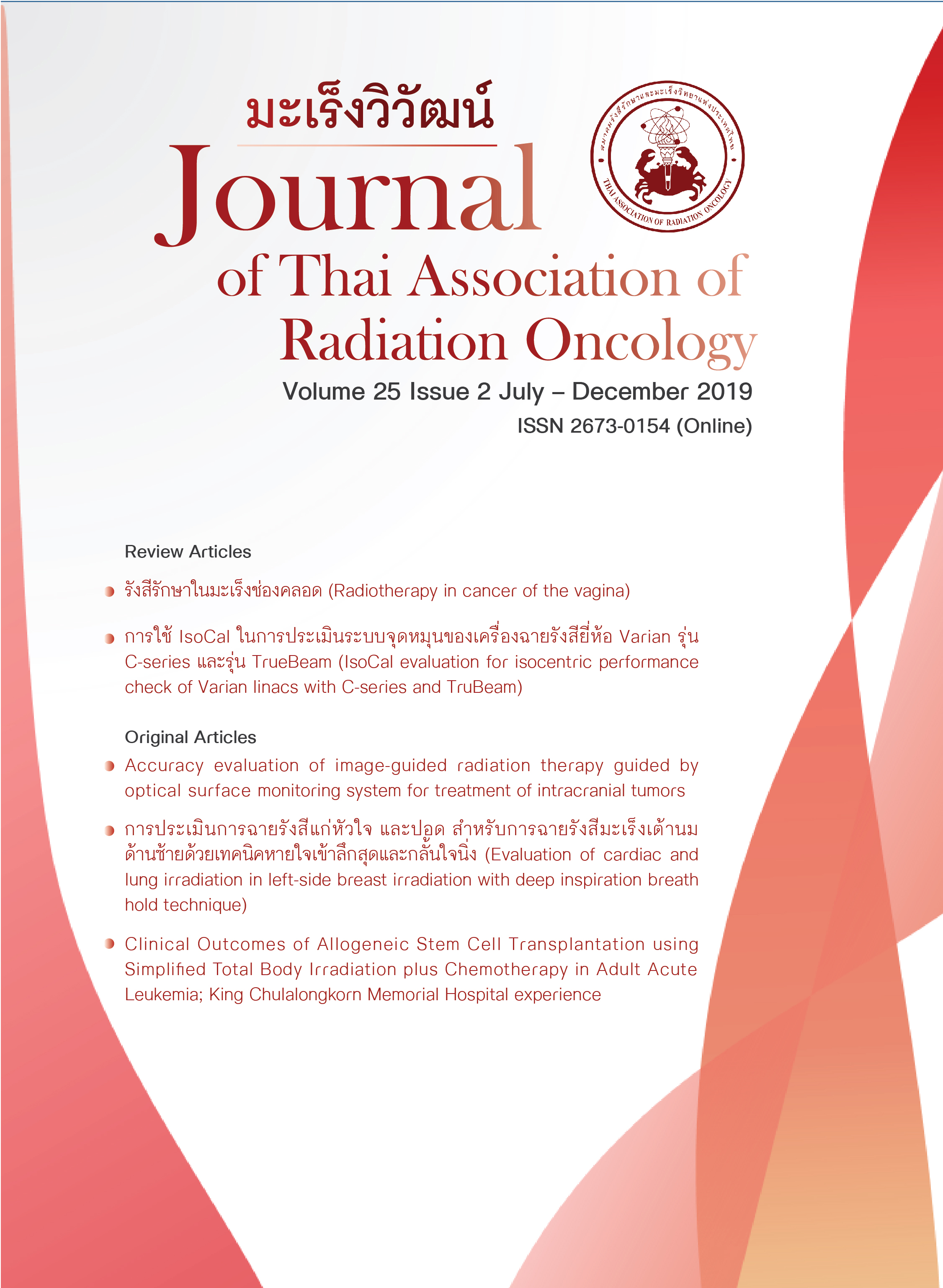Accuracy evaluation of image-guided radiation therapy guided by optical surface monitoring system for treatment of intracranial tumors
Keywords:
Image-guided radiation therapy, IGRT, intracranial tumors, optical surface monitoring system, OSMSAbstract
Background: Image-guided radiation therapy (IGRT) is an advanced radiation treatment that creates an image of the tumor to guide the radiation beam during radiation therapy. Importantly, the use of ionizing radiation for daily IGRT may subject patients to an unnecessarily cumulative dose of radiation. The optical surface monitoring system (OSMS) is a non-ionizing radiation IGRT technique that was developed to provide continuous motion tracking during real-time treatment without increasing patient exposure to ionizing radiation.
Objective: The aim of this study was to investigate the accuracy of IGRT guided by OSMS for the treatment of intracranial tumors.
Materials and Methods: This retrospective analysis of prospectively collected data included 62 consecutive patients that were treated for intracranial brain tumor with IGRT guided by OSMS at the Ramathibodi Radiosurgery Center during January 2016 to December 2017.
Results: A median prescribed dose of 50 Gy (range: 36-60) in 25 fractions (range: 22-30) was used. The median planning target volume was 20.65 cm3 (range: 0.4-485). The mean set-up error measured on pretreatment cone beam computerized tomography (CBCT) and OSMS was very small (<1 mm, 1 degree) in all directions. The maximum mean difference of deviation between CBCT and OSMS was 0.29±0.17 mm in lateral direction, and 0.08±0.14° in pitch direction. Less than 5% of patients needed to be repositioned during treatment. The treatment was well-tolerated by all patients, and no severe treatment-associated toxicity was reported.
Conclusion: IGRT guided by OSMS was found to be an efficacious, radiation-limiting treatment method for the management of intracranial tumors.
References
Alaei P, Spezi E. Imaging dose from cone beam computed tomography in radiation therapy. Phys Med. 2015;31:647-58.
Wen N, Li H, Song K, Chin-Snyder K, Qin Y, Kim J, et al. Characteristics of a novel treatment system for linear accelerator-based stereotactic radiosurgery. J Appl Clin Med Phys. 2015;16:125-48.
Peng JL, Kahler D, Li JG, Samant S, Yan G, Amdur R, et al. Characterization of a real-time surface image-guided stereotactic positioning system. Med Phys. 2010;37:5421-33.
Van Herk M, Remeijer P, Rasch C, Lebesque JV. The probability of correct target dosage: dose-population histograms for deriving treatment margins in radiotherapy. Int J Radiat Oncol Biol Phys. 2000;47:1121-35.
Cervino LI, Detorie N, Taylor M, Lawson JD, Harry T, Murphy KT, et al. Initial clinical experience with a frameless and maskless stereotactic radiosurgery treatment. Pract Radiat Oncol. 2012;2:54-62.
Oliver JA, Kelly P, Meeks SL, Willoughby TR, Shah AP. Orthogonal image pairs coupled with OSMS for noncoplanar beam angle, intracranial, single-isocenter, SRS treatments with multiple targets on the Varian Edge radiosurgery system. Adv Radiat Oncol. 2017;2:494-502.
Li G, Ballangrud A, Chan M, Ma R, Beal K, Yamada Y, et al. Clinical experience with two frameless stereotactic radiosurgery (fSRS) systems using optical surface imaging for motion monitoring. J Appl Clin Med Phys. 2015;16:149-62.
Zhao B, Maquilan G, Jiang S, Schwartz DL. Minimal mask immobilization with optical surface guidance for head and neck radiotherapy. J Appl Clin Med Phys. 2018;19:17-24.
Ma Z, Zhang W. Optical surface management system for patient positioning in interfractional breast cancer radiotherapy. Biomed Res Int. 2018;6415497.
Wikstrom K, Nilsson K, Isacsson U, Ahnesjo A. A comparison of patient position displacements from body surface laser scanning and cone beam CT bone registrations for radiotherapy of pelvic targets. Acta Oncol. 2014;53:268-77.
Gaisberger C, Steininger P, Mitterlechner B, Huber S, Weichenberger H, Sedlmayer F, et al. Three-dimensional surface scanning for accurate patient positioning and monitoring during breast cancer radiotherapy. Strahlenther Onkol. 2013;189:887-93.
Mancosu P, Fogliata A, Stravato A, Tomatis S, Cozzi L, Scorsetti M. Accuracy evaluation of the optical surface monitoring system on EDGE linear accelerator in a phantom study. Med Dosim. 2016;41:173-9.
Lau SK, Patel K, Kim T, Knipprath E, Kim GY, Cervino LI, et al. Clinical efficacy and safety of surface imaging guided radiosurgery (SIG-RS) in the treatment of benign skull base tumors. J Neurooncol. 2017;132:307-12.
Pan H, Cervino LI, Pawlicki T, Jiang SB, Alksne J, Detorie N, et al. Frameless, real-time, surface imaging-guided radiosurgery: clinical outcomes for brain metastases. Neurosurgery. 2012;71:844-51.
Li G, Ballangrud A, Kuo LC, Kang H, Kirov A, Lovelock M, et al. Motion monitoring for cranial frameless stereotactic radiosurgery using video-based three-dimensional optical surface imaging. Med Phys. 2011;38:3981-94.
Downloads
Published
How to Cite
Issue
Section
License
บทความที่ได้รับการตีพิมพ์เป็นลิขสิทธิ์ของวารสารมะเร็งวิวัฒน์ ข้อความที่ปรากฏในบทความแต่ละเรื่องในวารสารวิชาการเล่มนี้เป็นความคิดเห็นส่วนตัวของผู้เขียนแต่ละท่านไม่เกี่ยวข้องกับ และบุคคลากรท่านอื่น ๆ ใน สมาคมฯ แต่อย่างใด ความรับผิดชอบองค์ประกอบทั้งหมดของบทความแต่ละเรื่องเป็นของผู้เขียนแต่ละท่าน หากมีความผิดพลาดใดๆ ผู้เขียนแต่ละท่านจะรับผิดชอบบทความของตนเองแต่ผู้เดียว




